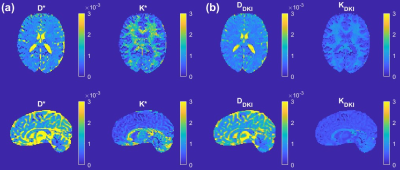Qianqian Yang1 and Viktor Vegh2,3
1Queensland University of Technology, Brisbane, Australia, 2The University of Queensland, Brisbane, Australia, 3Centre for Innovation in Biomedical Imaging Technology, Brisbane, Australia
1Queensland University of Technology, Brisbane, Australia, 2The University of Queensland, Brisbane, Australia, 3Centre for Innovation in Biomedical Imaging Technology, Brisbane, Australia
We derived a direct mathematical link between DKI and anomalous sub-diffusion models and provided a new alternative and explicit way to compute kurtosis, leading to superior grey-white matter contrast compared to traditional DKI metric.

Figure 3. Comparison of diffusivity and
kurtosis estimated from (a) the sub-diffusion and (b) DKI models. Top row:
axial view; bottom row: mid-sagittal view. $$$D^*$$$ and $$$K^*$$$ have been computed based on sub-diffusion model
parameters $$$D_{SUB}$$$ and $$$\beta$$$; $$$D_{DKI}$$$ and $$$K_{DKI}$$$ have been
estimated by fitting the standard DKI model to the data.

Figure 2. Link between sub-diffusion and
DKI models: (a) plot of the natural logarithm of the sub-diffusion model and
its approximations. Mono-exponential (MONO) and DKI are the first- and
second-order approximations of the sub-diffusion model, respectively; (b)
relationship between kurtosis $$$K^*$$$ and $$$\beta$$$; (c) relationship between the
ratio $$$D^*/D_{SUB}$$$ and $$$\beta$$$. $$$D^*$$$ and $$$K^*$$$ are the diffusivity and kurtosis
computed from sub-diffusion model parameters $$$D_{SUB}$$$ and $$$\beta$$$.